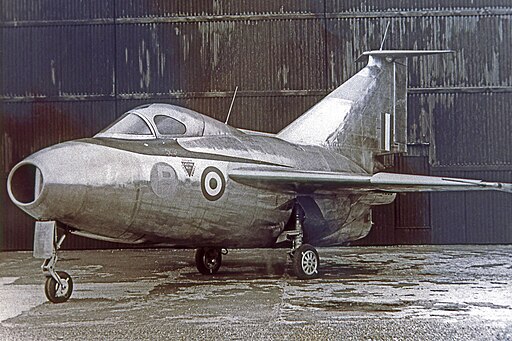
ASN Wikibase Occurrence # 154049
This information is added by users of ASN. Neither ASN nor the Flight Safety Foundation are responsible for the completeness or correctness of this information.
If you feel this information is incomplete or incorrect, you can submit corrected information.
| Date: | Monday 6 February 1956 |
| Time: | day |
| Type: | Fairey Delta FD.1 |
| Owner/operator: | Fairey Aviation |
| Registration: | VX350 |
| MSN: | F8477 |
| Fatalities: | Fatalities: 0 / Occupants: 1 |
| Aircraft damage: | Destroyed |
| Location: | Boscombe Down, Wiltshire -
 United Kingdom United Kingdom
|
| Phase: | Landing |
| Nature: | Test |
| Departure airport: | White Waltham, Berkshire (EGLM) |
| Boscombe Down, Wiltshire (EGDM) | |
| Confidence Rating: |
In the late 1940s, with the Miles M52 straight-wing jet cancelled by the Labour Government, Britain was trailing far behind in supersonic aircraft design. To try to retrieve matters the Ministry of Supply issued specification ER 103 for a supersonic research aircraft, and the Stockport based Fairey company set about meeting this with a delta-winged aircraft designed for investigation into flight and control at transonic and supersonic speeds.
The sole Fairey Delta 1 - VX350 - had begun life as a zero-feet-launch interceptor project and would have had a small but very powerful Rolls Royce turbojet to lift it off a ramp, efflux gases passing through steerable nozzles under the tail to provide control until the 19'6" span wings could generate aerodynamic lift. Once the ramp fighter idea had been abandoned however, VX350 spent a useful career testing different tail and control configurations for transonic speeds.
The only FD1 to be completed was built at Fairey's Heaton Chapel Stockport factory and taken by road to their test facility at Manchester's Ringway Airport for final assembly. Starting on 12 May 1950 it made several high-speed taxi runs down the 4,200-foot main runway there before being partially dismantled and transported by road to the Aeroplane and Armament Experimental Establishment (AAEE) at RAF Boscombe Down. After further taxi tests, the aircraft (serial number VX350) made its maiden flight on 12 March 1951; flown by Fairey test pilot Group Captain R. Gordon Slade, this flight lasted for 17 minutes.
The FD1 underwent extensive flight testing, which largely focused on exploring its lateral and longitudinal stability, as well as its overall flying characteristics. These flights helped determine that the aircraft possessed serious stability problems; its lack of stability led to the aircraft being often characterized as being "dangerous."
Following a landing accident that occurred in September 1951, the FD1 was grounded for two years. During this time, it received several modifications; changes included the removal of the temporary slots, as well as the deletion of the streamlined housings for the anti-spin parachutes that were mounted at the wingtips. The large control surfaces have been attributed with causing difficulty in controlling the FD1, making it hard to fly with precision, although it could achieve a rapid roll rate.
During 1953, the flight test programme was terminated by the Air Ministry, resulting in the withdrawal of state support for the FD1. Only a single FD1 (VX350) was built; the second (VX357) and third (VX364) airframes were cancelled prior to production commencing. This decision was not regarded as being a particularly heavy blow to Fairey, even in terms of the firm's ambitions to explore high speed delta wing aircraft, as detailed design work had already commenced on the more capable and sleeker-looking Fairey Delta 2 during the previous year.
Following the programme's cancellation, the sole aircraft continued to be flown for a time by Fairey to perform trials work. On 6 February 1956, the FD1 was damaged beyond repair in a landing accident at Boscombe Down. In October 1956, the aircraft was transported by road for use as a static target on the Shoeburyness weapons range, after which it was later scrapped. Fairey had spent £382,000 of their own money on the FD1.
Sources:
1. https://en.wikipedia.org/wiki/Fairey_Delta_1
2. http://www.vicflintham.co.uk/post-war-research-aircraft-and-prototypes/Deltas.html
3. http://www.ukserials.com/losses-1956.htm
4. http://www.levyboy.com/aviation.htm
5. http://www.ukserials.com/results.php?serial=VX
6. https://abpic.co.uk/pictures/model/Fairey%20Delta%201
7. https://1000aircraftphotos.com/Contributions/VanTilborg/2653.htm
Media:
The Sole Fairey Delta 1 VX350 at Ringway Airport, Manchester 12 May 1950:


Revision history:
| Date/time | Contributor | Updates |
|---|---|---|
| 13-Mar-2013 23:54 | Dr. John Smith | Added |
| 13-Mar-2013 23:56 | Dr. John Smith | Updated [Narrative] |
| 29-Jan-2014 19:27 | TB | Updated [Source, Embed code, Narrative] |
| 11-Jun-2020 21:46 | Dr. John Smith | Updated [Time, Cn, Location, Departure airport, Destination airport, Source, Embed code, Narrative] |
Corrections or additions? ... Edit this accident description
The Aviation Safety Network is an exclusive service provided by:


 ©2024 Flight Safety Foundation
©2024 Flight Safety Foundation